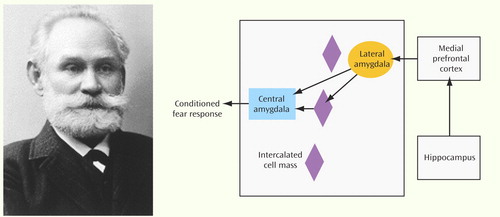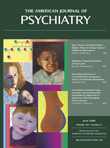The Anatomy of Fear Extinction
Pavlovian fear conditioning and its extinction are related laboratory procedures carried out in animals to model the mechanisms of human fear learning and its reversal. In humans, contextual (situational) fear is learned during traumatic episodes with fearful stimuli and is enhanced by genetic predisposition. The mechanisms of fear learning and extinction have been extensively studied in animals and are beginning to be examined in humans (see the study by Monk et al. in this issue). Simplistically, in the context of normal human life, fearful situations are regularly encountered; characteristically, these are managed successfully, then forgotten. However, when the fearful situation is overwhelming or the mediating neural systems function sub-optimally, fearful situations can be learned but not forgotten, creating forms of anxiety (e.g., PTSD, generalized anxiety disorder). Understanding the precise neural mechanisms of anxiety is necessary for developing selective and effective treatments; models of fear conditioning and extinction are tools to understand the neural mechanisms of anxiety. The animal literature is rich with molecular and systems research about fear conditioning and extinction. These data show that the amygdala is involved in remembering the fear-based situation, and that the extinction of that fear learning involves the medial and ventral prefrontal cortex acting on the amygdala ( Figure , right). Animal studies have implicated transmitters such as glutamate (NMDA), GABA, and cannabinoids in the mediation of fear learning and extinction in the amygdala. Excitatory projections from the ventral/medial prefrontal cortex descend to the lateral amygdala, which sends excitatory projections to the central amygdala and to the inhibitory neurons in the intercalated cell masses; these inhibitory neurons negatively modulate the central amygdala. Prefrontal cortex projections suppress amygdala-processed fear responses, thus inhibiting the fear responses and enhancing extinction. The hippocampus appears to set the limits for ventral/medial prefrontal cortex control over the fear circuitry of the lateral and central amygdala. Synaptic plasticity within the lateral amygdala mediates both fear learning and its extinction; this plasticity can likely be impacted by using selective pharmacological and cognitive tools to modulate the consequences of fear learning (e.g., anxiety) or of extinction (e.g., anxiety treatment). This research and its results are the basis for postulating that effective treatments already being used for anxiety disorders, such as cognitive behavioral therapy (CBT), can be rationally enhanced to optimize and enhance CBT action.

Figure 1. The fear extinction model has its origins in the classical conditioning that Ivan Petrovich Pavlov (left) first developed in dogs. Specific molecular events within the lateral amygdala facilitate extinction of fear learning (the conditioned fear response) hypothetically by stimulating inhibitory intercalated cell mass activity on the central amygdala. Regions within the prefrontal cortex (ventral and medial aspects) have an inhibitory influence on fear learning in the lateral and central amygdala, an influence modulated by hippocampal input to the ventral/medial prefrontal cortex. Circuit drawing modified from Sotres-Bayon F, Bush DEA, LeDoux JE: Emotional perseveration: an update on prefrontal-amygdala interactions in fear extinction. Learn Mem 2004; 11:525–535.



